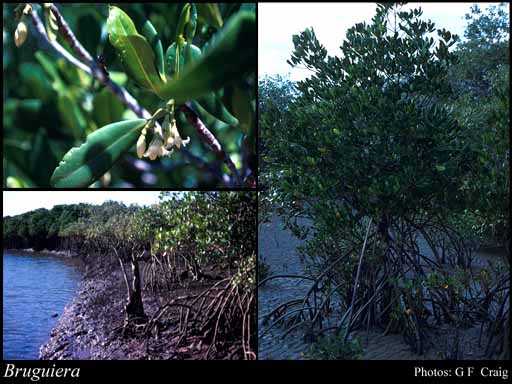- Reference
- Tabl.Encycl. 2:Pl.397 (1793)
- Name Status
- Current







Scientific Description
Family Rhizophoraceae.
Habit and leaf form. Trees. Leaves cauline. Stem internodes with lacunae, swollen at nodes on branchlets. Helophytic (tidal habitats, backwaters). Leaves opposite; decussate (A), or not decussate (C); leathery; petiolate; simple. Leaf blades entire; pinnately veined. Leaves with stipules. Stipules interpetiolar (sheathing the terminal bud); with colleters (secreting mucilage), or without colleters; caducous (leaving annular scar, 2–4 cm long, interpetiolar). Leaf blade margins entire. Leaf anatomy. Hairs absent. Extra-floral nectaries absent. Stem anatomy. Secondary thickening developing from a conventional cambial ring. Roots. Aerial roots present (roots often buttressed at base and with knee-like pneumatophores).
Reproductive type, pollination. Fertile flowers hermaphrodite. Unisexual flowers absent. Plants hermaphrodite. Plants viviparous.
Inflorescence and flower features. Flowers solitary, or aggregated in ‘inflorescences’; when solitary, axillary; when aggregated, in cymes (of 2–10 flowers). The terminal inflorescence unit cymose, or racemose. Inflorescences axillary. Flowers pedicellate; ebracteate; ebracteolate; regular. Free hypanthium present; campanulate, or turbinate; adnate to ovary. Perianth with distinct calyx and corolla; 16–32; 2 -whorled; isomerous. Calyx present; 8–16; 1 -whorled; polysepalous (AK); valvate; regular; fleshy (or leathery); persistent. Corolla present; 8–16; 1 -whorled; alternating with the calyx; polypetalous; contorted (or infolded); fleshy. Petals sessile. Corolla members bilobed, or fringed (or bristled, or with setae). Androecial members definite in number. Androecium 16–32. Androecial members free of the perianth (generally inserted on the outer edge of the perigynous or epigynous disk); markedly unequal (unequal pairs); free of one another; generally 1 -whorled. Androecium exclusively of fertile stamens. Stamens 16–32; all more or less similar in shape; diplostemonous; alternisepalous; filantherous, or with sessile anthers. Anthers dorsifixed; dehiscing via longitudinal slits; introrse; bilocular (KCB), or many locular (A); tetrasporangiate. Gynoecium 2–4 carpelled. The pistil 2–4 celled. Carpels reduced in number relative to the perianth, or isomerous with the perianth. Gynoecium syncarpous; eu-syncarpous; inferior. Ovary plurilocular; 2–4 locular. Epigynous disk present, or absent. Gynoecium stylate. Styles 1; apical. Stigmas 1; minutely 2–4 - lobed. Placentation axile to apical. Ovules 2 per locule; pendulous; epitropous; with ventral raphe; arillate, or non-arillate; hemianatropous, or anatropous.
Fruit and seed features. Fruit fleshy (coriaceous); indehiscent; a berry; 1 celled; 1 seeded (usually). Seeds copiously endospermic. Endosperm oily (and fleshy). Embryo well differentiated. Cotyledons 2. Embryo straight. Micropyle zigzag.
Special features. Mangroves.
Etymology. After Jacobus Breynius (or Breyne; 1637–97), merchant and botanist of Danzig; and his son Joannes Philippus Breynius (1680–1764), physician and botanist of that city, who collected and described the flora of Ceylon.
Taxonomic Literature
- Wheeler, J. R.; Rye, B. L.; Koch, B. L.; Wilson, A. J. G.; Western Australian Herbarium 1992. Flora of the Kimberley region. Western Australian Herbarium.. Como, W.A..